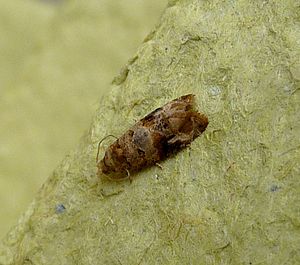Crossed grape moth
| Crossed grape moth | ||||||||||||
|---|---|---|---|---|---|---|---|---|---|---|---|---|

Crossed grape moth ( Lobesia botrana ) |
||||||||||||
| Systematics | ||||||||||||
|
||||||||||||
| Scientific name | ||||||||||||
| Lobesia botrana | ||||||||||||
| ( Denis & Schiffermüller , 1775) |
The crossed grape ( Lobesia botrana ) is a butterfly ( moth ) from the family of Winder (Tortricidae).
features
The moth has a five to six millimeter body and a wingspan of 12 to 13 millimeters. The wings are marbled yellow-green to greyish.
Synonyms
- Lobesia vitisana Jacquin , 1788
distribution
The crossed grape moth occurs in all southern and central European wine-growing regions. It is also widespread in North Africa , Asia Minor and the Caucasus . The northern wine-growing limit is not exceeded. In the European vineyards, the species has been around since 1910 ( Switzerland ).
The crossed grape moth prefers warm, dry regions.
Way of life
The species is polyphagous (so does not concentrate exclusively on vines), nocturnal, lively and likes to wander. The pupae of the crossed grape moth overwinter under the bark of the vine . It has so far been found on over 20 host plants of the following genera:
- Grapevines ( vitis )
- Clematis ( Clematis )
- Dogwood ( Cornus )
- Honeysuckle ( Lonicera )
- Snowball ( viburnum )
- Privet ( ligustrum )
- Gooseberry ( Ribes )
- Ivy ( hedera )
- Daphne ( Daphne )
- Rosemary ( rosmarinus )
- Barberry ( Berberis )
Flight time
It forms two, in very warm years also three generations a year, which are differentiated according to the caterpillars in hayworm, sourworm and sweetworm:
- Generation ( hayworm ) in late April / early May
- Generation ( sour worm ) end of June / mid-July
- Generation ( sweet worm ) only in warm years and favorable conditions in mid-September / early October
The flight times of the individual generations often overlap and cannot always be separated. Flight, mating and oviposition mainly take place in the evening hours.
Harmful effect
The crossed grape moth, like the single-knot grape moth, is a pest in viticulture. The larvae of both curlers attack the flowers and grapes and thereby reduce the yield. Infested grapes are much more susceptible to gray mold rot ( Botrytis cinerea ) due to the damage caused by feeding . The botrytis infestation only causes significant damage to the grapes.
Combat
The grape moth is combated with insecticides , which are often used preventively. Alternatively, the population size is determined with pheromone traps and then the infestation is fought specifically with pesticides. When biological control you bet on the disrupter , and various natural enemies.
swell
Individual evidence
- ↑ Lobesia (Lobesia) botrana (Denis & Schiffermüller 1775). Fauna Europaea, Version 1.3, April 19, 2007 , accessed on January 10, 2008 .
Web links
- Grape moth - Vine Protection Service Lower Austria
- Image on www.lepiforum.de
- Collection of the Natural History Museum Stockholm (Swedish), illustration
- Information service of the Agriculture Administration of Baden-Württemberg: The one-knot and the crossed grape moth ( PDF file; 26 kB)
- Brochure from the Bavarian State Institute for Viticulture and Horticulture on beneficial insects and pests in the vineyard (PDF file; 959 kB)
- Bayercropscience